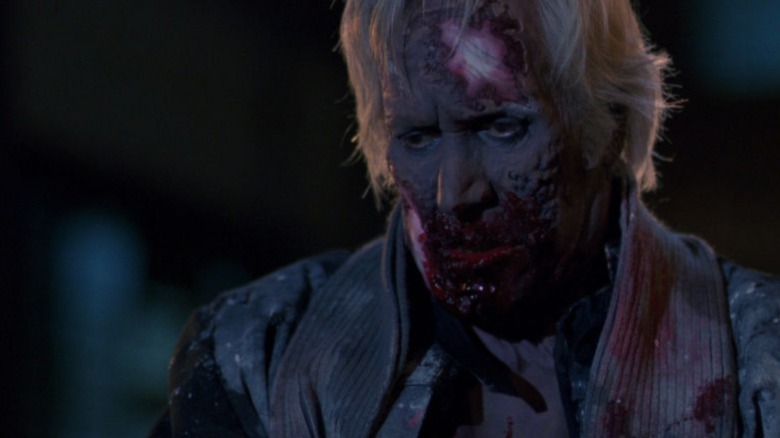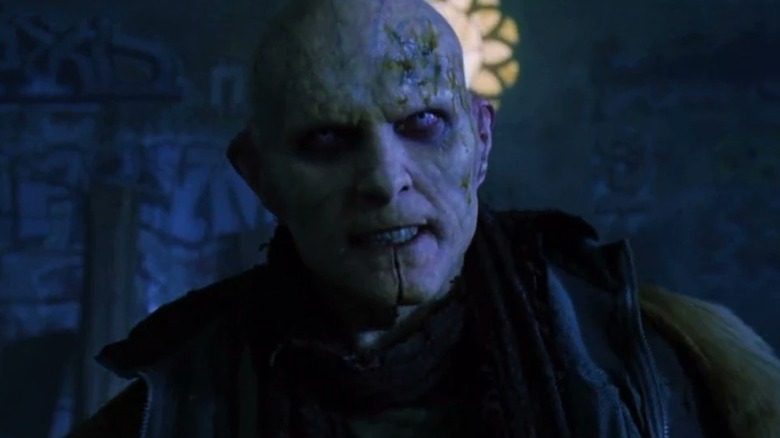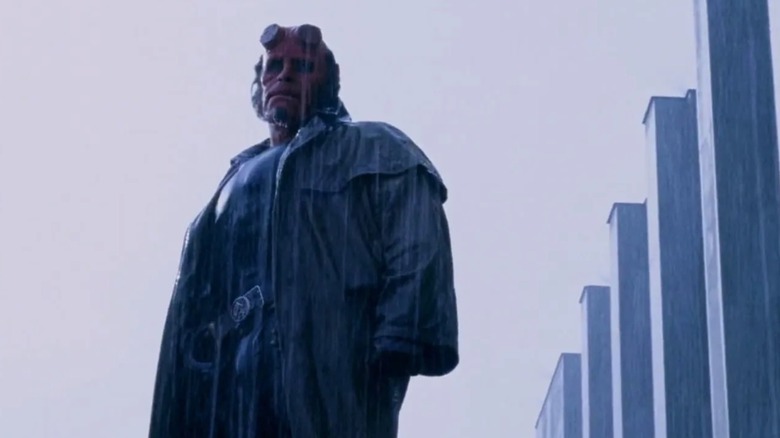Guillermo Del Toro Thinks Four Of His Past Movies Were Actually Frankenstein Stories
"Only four?" If you're asking that after that headline, you're not alone. Guillermo del Toro has finally made the glorious "Frankenstein" movie he's wanted to make since he was a child. Yet you can see the echoes of Mary Shelley and James Whale in every movie del Toro has made. His brand as a storyteller is misunderstood monsters and tumultuous father-son relationships, the hallmarks of any "Frankenstein" iteration.
In a recent appearance on the "Indiewire Filmmaker's Toolkit" podcast, del Toro listed four of his films that he thinks are especially close to "Frankenstein" — "Cronos," "Mimic," "Blade II," and "Hellboy."
"Cronos," del Toro's first feature film, stars Jesús Gris (Federico Luppi), an old Mexican man transformed into a vampire. Not through a bite, but through a clockwork device created by an immortality-seeking alchemist (someone just like Dr. Frankenstein). Jesús' pale vampiric appearance resembles Boris Karloff as the Creature. "The scar is a Frankenstein scar on his forehead," del Toro said to IndieWire:
In del Toro's "Frankenstein," he adds a new dimension to the Creature's (Jacob Elordi) torment; he cannot die, so there is literally no way for him to escape a life of rejection and pain. Del Toro adds a breathtaking scene where the Creature steals a stick of dynamite from his creator (Oscar Isaac) and demands Victor light it. The Creature holds it close, praying the small spark on the fuse is his salvation. Alas, the dynamite explodes and his body heals as it always does.
"Cronos" is another film about the pain of eternal life, and one where the sun (anathema to vampires) represents life. One of the key changes del Toro makes to the "Frankenstein" novel is ending the story with the Creature accepting himself, symbolized by him standing in a warm sunrise.
Blade II and Mimic are tales of science gone wrong
"Mimic," del Toro's second film and his first fully English-language one, reflects the mad science side of the "Frankenstein" story. Dr. Susan Tyler (Mira Sorvino) created a "Judas breed" of insects to kill a strain of disease-spreading cockroaches. Within a few years, she and colleagues learn the Judas bugs never stopped evolving. Living in the sewers of Manhattan, they've grown man-sized and threaten to overrun the city.
During the production of "Mimic," del Toro clashed with the heads of studio Miramax, the now disgraced brothers Harvey and Bob Weinstein. His experience with the Weinsteins was apparently so bad that, in 2017, del Toro compared it to his father's kidnapping in 1997. "The kidnapping made more sense, I knew what they wanted," del Toro joked to IndieWire.
"Mimic" is thus not quite the movie that del Toro intended (though he released a director's cut in 2011). You can see that in how the movie doesn't treat the monsters as majestic; the Judas bugs are creepy and terrifying, a blight that must be exterminated.
The next studio picture del Toro made, "Blade II," went better. Blade (Wesley Snipes) is forced into an alliance with his vampire prey to hunt down Jared Nomak (Luke Goss). Nomak carries the "Reaper" virus, turning vampires extra monstrous to the point they feed on other vampires.
The third act reveals Nomak is the son of vampire lord Eli Damaskinos (Thomas Kretschmann), who experimented on his boy to create a vampire without their kind's typical weaknesses. Damaskinos is Doctor Frankenstein and Nomak is the Creature, but like in del Toro's "Frankenstein," the father is the true monster, not the son.
Guillermo del Toro portrayed Hellboy like Frankenstein's Monster
After "Blade II," del Toro adapted artist Mike Mignola's gothic pulp comic book hero, Hellboy. Summoned to Earth in 1944 by the Nazis, Hellboy was raised by Professor Trevor Bruttenholm ("Broom") and now works as an agent of the Bureau for Paranormal Research and Defense. Though he's the destined harbinger of the apocalypse, Hellboy's a good-natured (if gruff) guy.
"Hellboy" by del Toro is visually faithful to the comics, and Ron Perlman is cast perfectly as Hellboy. Yet del Toro also delivers a lonelier, more emotional mood. In doing so, del Toro turned Hellboy into an outcast like Frankenstein's Monster. Like he later did with "The Shape of Water" and "Frankenstein," del Toro can't resist having his female lead choose the monster over the man.
In the comics, Hellboy is a public celebrity. He sometimes feels like he doesn't belong among humans, but those feelings are brief and subdued. In the movies, Hellboy angsts at having to hide from people just like the Creature did; he even watches his own father's funeral from the shadows. Speaking of, del Toro's "Hellboy" centers the uneasy father-son relationship between Hellboy and Broom (John Hurt). In the comics, Broom dies in the very first "Hellboy" arc, "Seed of Destruction."
The del Toro movie wound up being a reflexive influence on the comics. In the climactic "Hellboy" mini-series "The Storm and the Fury" (written by Mignola, drawn by Duncan Fegredo), Hellboy recalls Broom reassuring him he's not a monster like Frankenstein's Creature.
Mignola is another "Frankenstein" devotee, but this is another difference between him and del Toro. To del Toro, Hellboy is like the Monster and that's to be celebrated.
Guillermo del Toro's "Frankenstein" is streaming on Netflix.




